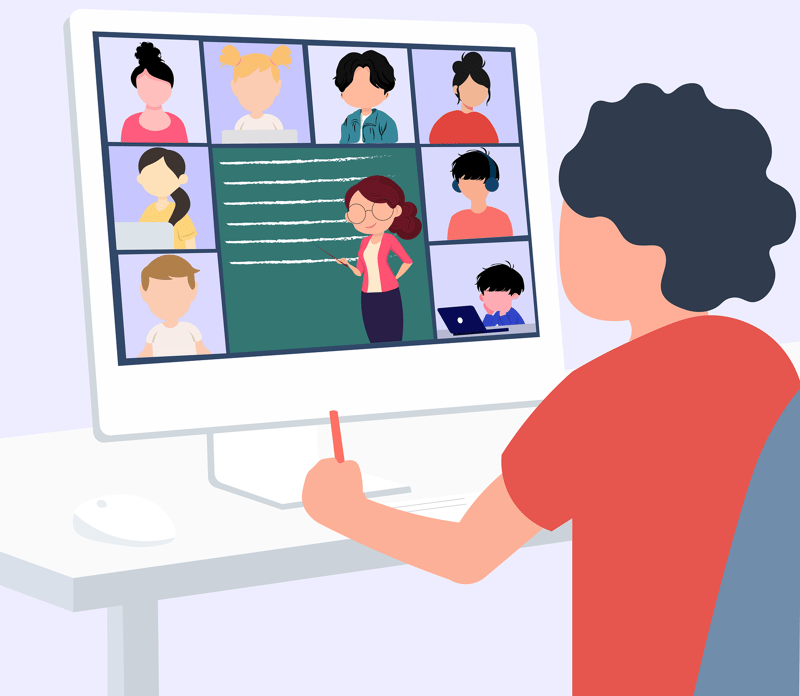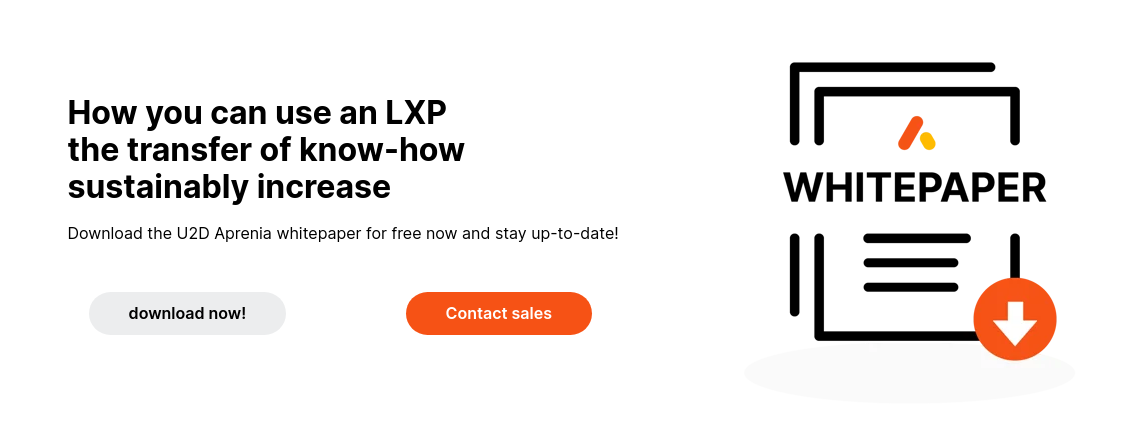E-learning: History of digital learning
The history of innovation is also a history of learning. In this blog article, you will learn how learning has evolved to digital learning and why e-learning is now an indispensable component of corporate culture.

05.08 - Day of the "Abrackering "
Tomorrow, 05.08.2023, we will experience the so-called day of the "Abrackering". We can well understand if only a few people are aware of this day of action. But it is stimulating for a topic that is far too seldom associated with "working off" - after all, when we think of this substantive verb, we usually think of physical labour. However, office workers would also refer to their activities as "toiling away".
Mental exertion also takes a lot of energy - especially since it is not infrequently associated with psychological pressure. Continuing this thought, another field of thought opens up: learning. Students are often assumed to have a comfortable standard of living. They spend fewer hours a week at school than "normal" employees in their jobs, are unemployable and have many more "holiday weeks" than their employed peers.
The situation is similar for students. Often forgotten in social debates is the social and psychological pressure that results from giving up learning. Working hard therefore very much includes the study of knowledge. Through cognitive knowledge and learning from each other, human beings have entered the stream of innovation that has allowed their development to progress so far.
The ways in which we learn are also constantly evolving. In the digital age, e-learning is taking on an increasingly important role - both in schools and universities and in the world of work. Reason enough to take a look at the history of e-learning on the day of the "Abrackern".
What is e-learning anyway?
A simple definition is usually assumed behind this term - electronic learning. However, it turns out that this term can be interpreted very broadly. In the early 2000s, the term was not uniformly defined in academia. Terms such as Easy Learning, Effective Learning, Entertaining Learning, Elaborated Learning or even Electronical Learning were associated with e-learning at the time (Dichanz and Ernst, 2001). This is understandable when one considers that the megatrend of digitalisation - to which e-learning is subordinate - was itself still in its infancy in terms of social perception. In the meantime, however, there is a more uniform interpretation of this word:
E-learning is a form of learning that is supported by electronic, technical or digital media.
On the one hand, this explanation enables a more precise classification in the sense of the word, on the other hand, the term is also used for the fact of "learning something on a digital medium". An example of this is the LMS (Learning Management System) and the LXPs (Learning Experience Platform).
At the latest since the Corona pandemic, all sectors of society and generations have had to deal with the topic - pupils and teachers, students and lecturers, employees and employers. E-learning has become the new standard when it comes to knowledge transfer and social learning. But how long has e-learning actually existed?
The milestones of e-learning
The idea that e-learning is a fairly new practice of learning seems logical. In truth, however, this type of knowledge management does not have the most recent origin. The history of digital learning goes back a long way. If we consider what e-learning actually means - namely learning at a distance - it becomes clear that digital approaches to location-independent learning must have existed before.
Important milestones in the (American) history of e-learning are:- Mid-19th century: first distance learning courses
- Late 19th century: Telephone courses in Chicago
- Early 1920s: learning offered via radio
- 1960s and 1980s: beginning of computer use in schools and universities
- 1999s: Term "e-learning" is mentioned for the first time
- 2010s: E-learning used in almost all schools in the USA
- Present: Companies use e-learning almost exclusively

Types of e-learning
Not only the intensity of the use of e-learning has changed in recent years, but also the technical possibilities and thus the number of types.
On the one hand, a distinction is made between synchronous and asynchronous e-learning. The criterion here is the simultaneous presence of teachers and learners. While synchronous e-learning usually takes place as a live course (e.g. via Microsoft Teams) and both parties can interact with each other, in asynchronous e-learning the teaching material is made available online and the learners access it independently of the teacher. These two types are often found in education and training. During the Corona pandemic, this was mainly reflected in online teaching/lecturing and digital self-study - where students had to work through modules digitally and independently.
Another type is mobile learning. In this case, learning content is conveyed by means of mobile devices such as smartphones. They also enable more interactive teaching at schools and universities. Furthermore, there are often occasions in everyday life where mobile e-learning can be used: during driving lessons, at trade fairs, in everyday office life, in front of the TV (interactive quiz programmes) and in the office. Thus, learning content can be quickly and easily integrated into the learning software via app and recorded via smartphone. Mobility enables location-flexible access, which means that small learning units can also be accessed on the move.
So-called blended learning describes the combination of traditional face-to-face teaching and e-learning. Because location does not play a role in mobile e-learning, a connection is created when using e-learning via smartphones - most of the interactive examples mentioned in the previous paragraph are also handling patterns for blended learning.
Game-based learning picks up on the fun factor. Learners can learn and expand their knowledge in a playful way. This type of e-learning appeals to many age groups. For example, children learn through play in preschool and primary school, pupils and students use quiz platforms such as Khaoot, workers expand their know-how through LXPs with gamification such as U2D Aprenia and older people can keep fit with apps and programmes.
Advantages through e-learning
Through the history and the different types of e-learning, it is above all the advantages that this form of digital learning brings that stand out. Through the use of mobile devices, learning is possible regardless of time and place. This results in a generally higher flexibility. The interactivity is also advantageous, because learners can create content themselves and actively participate in the learning process of themselves and others.
Content creation is therefore no longer purely a matter for the boss. Pupils, students and employees all benefit from the interactivity that e-learning brings. It has a motivating and productivity-enhancing effect on learners. When it comes to modern and sustainable knowledge management, "analogue" learning processes are now a thing of the past.
If e-learning is examined in a business context, companies that design their knowledge transfer digitally - be it through onboarding, workflow management, social learning or offboarding, for example - also benefit from the time factor. Time resources and capacities can be optimised and bundled more compactly through e-learning in the company. This component thus has a positive effect on the cost structure in the economy.
The provision of digital content gives people a higher form of autonomy in their field of activity, as each character can shape their learning - by type and pace - using the content provided by the media.

E-learning through Aprenia
E-learning has been taken to the next digital level with the advent of LXPs. Our U2D Aprenia is a good example of how e-learning can be modernised in the company. The focus here is on the learning experience. Users benefit sustainably from the platform, which they can access at any time and from any device, either to create content in various media forms or to internalise content.
The aforementioned game factor and social interaction ensure that learning does not create rigid structures or hurdles that make knowledge transfer "dull and grey". Modern corporate cultures rely on e-learning through LXP to act in the best interests of their employees and their own economic productivity. Try U2D Aprenia today for free or arrange a no-obligation product demo with Aprenia CEO Stephan Ottenschläger.
Bibliography:
Dichanz, H., & Ernst, A. (2001). E-Learning: Begriffliche, psychologische und didaktische Überlegungen zum "electronic learning". MedienPädagogik: Zeitschrift für Theorie Und Praxis Der Medienbildung, 2(Virtualität und E-Learning), 1–30. https://doi.org/10.21240/mpaed/02/2001.06.27.X
Onlinekurse (2022). Die Geschichte des E-Learnings. https://www.onlinekurse.com/ratgeber/e-learning-geschichte/
